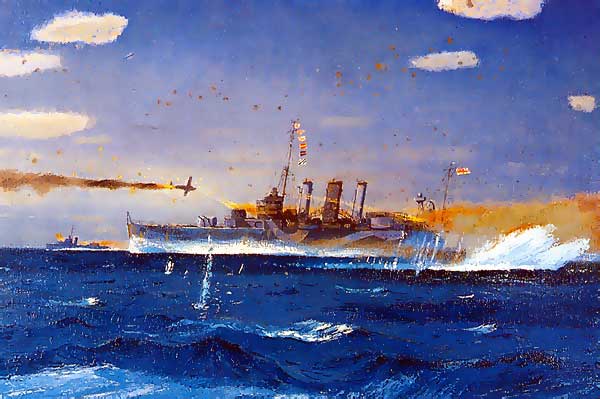|
Luftwaffe attack their own Destroyers on February 22nd. 1940
Introduction. On the occasion of Operation Wikinger, two Squadrons of Heinkel Bombers were staging an anti shipping operation at the same time as 6 Destroyers of the 1st. Destroyer Flotilla were at sea. Chaos was to become the Order of the Day. British Fishing Fleet. Reports had reached the Navy that several submarines were observed meeting up with these ships. Operation Wikinger.
It was a moonlit night, practically no cloud, and a light wind blowing from the south west,as the Flotilla sailed for the North Sea. The expected Luftwaffe fighter escort did not turn up. The Luftwaffe. The HE 111 was a twin engined medium bomber, with a 5 man crew and carried a bomb load of 3,250 kilograms.
Because of too much cloud, the morning sortie was called off, later that day the cloud had cleared, and a second attack was ordered to be prepared. Back to the 6 destroyers. At 1913 ( 7. 13 PM ) lookouts in the lead ship, Friedrich Eckhold heard the sound of aircraft engines, a few minutes later this noise was identified as an unknown aircraft flying overhead at only 500/800 metres. After passing the formation, the aircraft reversed its course and flew back over the Destroyers to disappear into the night. In but a few more minutes this aircraft reappeared, and the Flotilla speed was cut back to 17 knots to reduce the wake, thinking the aircraft was hostile as no recognition signal had been given, ships in the second and third place in the line, fired off their 20mm AA guns. The aircraft now returned machine gun fire, seemingly assuring all the ships it was an enemy plane. But Max Schulz reported this aircraft was in fact friendly, one of her lookouts had spotted a German Cross on a wing, but no one else wanted to accept that report, especially after that 1st. exchange of gunfire. At 1943 ( 7. 43 PM ) Max Schulz spotted the aircraft again, this time approaching the destroyer formation rear out of a cloud in front of the moon, she fired off a signal:
This destroyer, the first to be built in Germany post WW1 had despatched her last signal. Luftwaffe. About 1900 ( 7. P M ) the crew noticed a ship's wake below with a shadow in front of it, denoting a ship steaming which they took to be a freighter, they went round again to try to identify it. ( Now in WW2, airmen on both sides of the conflict had the greatest difficulty in accurately identifying ships they sighted from the air. eg, at the Battle of the Coral Sea, HMAS Australia leading an Allied Task Force was bombed by US B -17 aircraft, they fortunately missed their target, the B 17's rushed off home to their Townsville base to claim a Japanese ship sunk, on printing out the photos of the attack, they needed to eat humble pie when it was revealed it was Allied ships that they attacked. )
AA fire from the Flotilla greeted the Heinkel, this simply confirmed to its aircrew that it was an enemy ship below. The HE 111 climbed to make her bombing run, at a height of 1,500 metres the aircraft approached the dark shadow below with the black cloud in front of the moon behind it. In the Destroyer Flotilla, two minutes after the last radio message, two bombs exploded just astern of Leberecht Maas, the whole Flotilla let fly with their AA guns. Now a third bomb hit the destroyer between the superstructure and the foremost funnel, the ship slowed and pulled out of the line to starboard, signalling she had been hit and needed help. At 1956 ( 7.56 PM ) with Fredrich Eckolt closing the stricken ship, the aft AA guns in Leberecht Maas, erupted, then two explosions occured, one astern of Leberecht Maas, the 2nd. in the area of her second funnel. A large fire ball leapt into the night sky, followed by a smoke cloud blotting out the ship from view. When the smoke cleared, the destroyer was broken in two, both her bow and stern raised out of the water, and her crew of 330 faced with sinking into the 40 metres depth of the cold cold North Sea. Chaos Reigns. Theodor Reider only a 1,000 metres from this explosion reported a submarine to starboard, causing utter chaos and confusion in the group of ships. Theodor Reider dashed off after the submarine contact to let fly with four depth charges, they exploded too close to the destroyer, jamming her rudder, she was steaming around in circles until at last, manual control was able to be implemented. The Flotilla Commander ordered all rescue attempts to pick up survivors stopped, to hunt for the submarine now the top priority. Max Schulz could not be raised by signal, no response from her at all, and no ship had any idea of her whereabouts or health. She was GONE. Most likely she had run into a mine, and not been attacked from the air as reported. Withdrawal. On their way home, the awful cost in lives was revealed, only 60 from the crew of 330 in Leberecht Maas had been saved, another 308 sailors in Max Schulz had perished. Conclusion. It became obvious that the aircraft that attacked the German destroyers was one of their own HE 111's, neither the Luftwaffe bombers nor the Kreigsmarine Destroyers had been informed that other German forces were operating in the same area, so keep a vigilant lookout. Once again Friendly Fire had been at its deadly work. I believe the Flotilla Commander panicked when he received the Submarine report, and was responsible for so many of those survivors dying in the icy waters, he was fortunate to escape any sanction. 578 crewmen died, the end result of very poor interservice communications exercise. |



